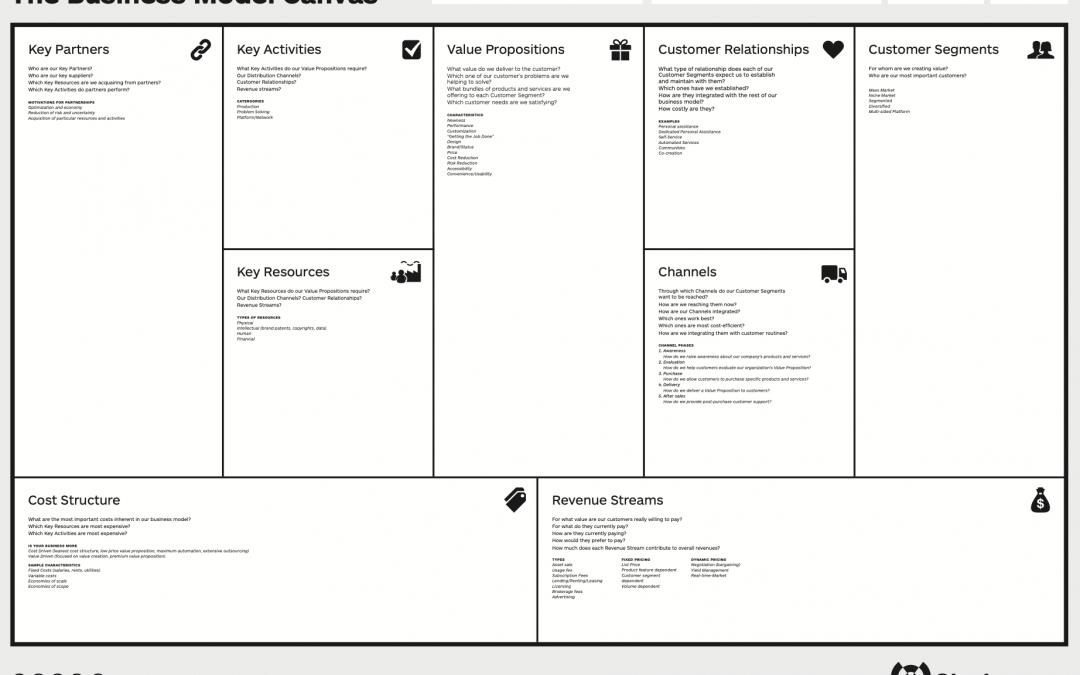It is important to understand and demonstrate how your particular department or team delivers value to the overall organisation (and ideally its customers) and how these benefits could be increased even further – while potentially reducing effort and cost.

Time
If you have mapped your stakeholders and understand their pains and gains it takes about 90 minutes to develop a first iteration of the BMC for your organisation.

People
Bring a good cross-section of co-workers from your department or team. As always, keep the group to a size of max. 7-8 people to be able to have a meaningful discussion.

Tools
Beyond printouts of the canvas you will need a selection of sticky notes and markers. Alternatively you can work online using the Mural template.
How to Use the Business Modell Canvas to Understand and Improve Your Team’s Value Delivery
Print the Business Model Canvas as a poster and work with sticky notes or use a digital canvas with an online collaboration tool like Mural or Miro.
1. Using the „Customer Segments“ field agree on your department’s or team’s key stakeholders. Who impacts your department and – more importantly – is impacted by the services or products your organisation provides. Focus on the top three. (You may want to perform a stakeholder analysis before and create stakeholder personas for the most important ones to document their needs and wants.). Use different color sticky notes for every stakeholder to be able to track their impact through the model.
2. In the „Value Proposition“ field outline the value proposition(s), i.e. services and (internal) products your organisation delivers catering to the stakeholder’s identified pains, needs, and wants (remember to use the colors associated with the respective stakeholders).
3. Specify the ways you deliver these value propositions in the „Channels“ field of the canvas. Using the BMC for teams, internal channels could e.g. be described as intranet sites where you offer certain services, processes in which you perform a crucial step, infrastructures that depend on your components, meetings where you deliver critical input, etc.
4. Detail the typical way you interact with your stakeholders using the „Customer Relationships“ field. Think again of (regular) meetings, email distribution lists, ticketing systems, tools like MS-Teams or Slack, …
5. Using the „Revenue Streams“ field, outline the concrete benefits the organisation (or parts thereof) derives from your activities. The more tangible like „% quality improvements“, „secured compliance of“, „improved customer service“, the better. If you can assign figures to the benefits, fantastic!
6. Describe the key activities that your organisation needs to perform – or have performed by someone – to deliver your Value Proposition to the identified key stakeholders using the „Key Activities“ field.
7. Which „Key Resources“ does your organisation require to be able to deliver your services or products (aka value propositions). Think of human resources with key capabilities, infrastructure, intellectual property, software licenses, machines, …
8. Which „Key Partnerships“ do you need to support you in delivering your value proposition. Think of other departments, outside vendors and the like!
9. Delineate the resulting „Cost Structure„. What requires resources, budgets, … Again, the more concrete the better.
Review the resulting picture. What contributes most to your department’s value delivery? Where and how can you improve by focusing on a particular stakeholder group’s needs or expanding your offering to adjacent stakeholders? Can you focus your department even more? Are there any activities that you could structure differently by splitting responsibilities with other organisations in alternative ways?
Decide on options and possibilities and develop a plan for exploring them (e.g. with your superiors) and follow through.
The Business Model Canvas was originally created by Alexander Osterwalder and Yves Pigneur and is a copyright of Strategyzer AG.

